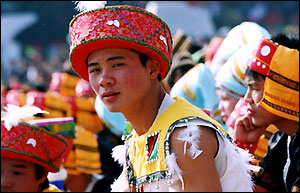Mulam ethnic group
- Population: 207,352
- Major area of distribution: Guangxi
- Language: Mulam
- Religion: Taoism and Buddhism
The Mulam ethnic minority has a population of 207,352, of which the majority live in Luocheng County in the Guangxi Zhuang Autonomous Region. Others are scattered in neighboring counties.
The Mulam language is a member of the Zhuang-Dong language group of the Chinese-Tibetan language family, but because of extensive contacts with the majority Han and local Zhuangs many Mulams speak one or both of these languages in addition to their own.
Their homeland is one of rolling hills interspersed with lush green valleys. The Wuyang and Longjiang rivers cross their territory, which has an ideal climate for growing paddy rice, maize, beans, potatoes, melons and cotton. The area is famous for its tea and medicinal herbs, as well as mineral resources such as coal, iron and sulfur.
History
Historical records trace the Mulam ethnic group back to the period of the Yuan Dynasty (1271-1368), when their society seems to have been entering the feudal stage. The Mulam villages paid tribute in grain to the imperial court twice a year.
In the Qing Dynasty (1644-1911) the Mulam areas were divided into "Li," under which were "Dongs" – units of ten households.
The Dong chief was responsible for collecting taxes and law and order. The Dongs were mostly inhabited by families sharing the same surname. Later, when they increased in size, the Dongs were divided into "Fangs."
Economy
Even prior to 1949, the farming economy of the Mulams was comparatively advanced. Farming techniques, crop varieties and tools were basically the same as those of their Han and Zhuang neighbors. Oxen and water buffaloes were the main draught animals, although horses were sometimes used also. Some 60 percent of arable land was taken up by paddy fields, and the Mulams had long known the use of manure fertilizer.
The Mulams' well-developed irrigation system, unfortunately, was under the control of the rich landlords, who channeled most of the water off for themselves. The encroachment of insects and wild animals was a serious problem for the Mulam farmers.
In the past, each household was a basic production unit. The division of labor between men and women was not strict, but ploughing, carrying manure and threshing were usually men's jobs, while women did the rice transplanting, sowing and housework.
Also well developed were sideline products, which included collecting medicinal herbs, raising livestock, blacksmithing, making pottery and weaving cloth.
Prior to the founding of the People’s Republic of China, land in the Mulam areas was heavily concentrated in the hands of the rich landlords, especially the most fertile parts. The landlords demanded that their tenants pay rent in kind and provide unpaid labor service. They also exploited the poorer peasants by means of usury.
Customs and culture
Mulam houses consist of three rooms, usually one-storied, with mud walls and tile roofs. Inside, on the left of the door, the ground is dug away to form a cooking pit. The livestock are kept away from the living quarters.
Rice, maize and potatoes are the staple diet of the Mulams, who also enjoy eating hot peppers and glutinous rice. It is taboo to eat cats or snakes. Mulams who bear the surnames Luo and Wu are forbidden to eat dog meat or the internal organs of animals.
The Mulams used to be famous for their spinning, weaving and dyeing, and their favorite color is deep blue. Traditionally, men wore jackets with large buttons down the front, long, baggy trousers and straw sandals. Young girls wear their hair in braids, which is coiled up onto their heads after marriage. Women's jewelry includes silver earrings, bracelets and finger rings.
Early marriage arranged by the parents was common before 1949. Brides did not live with their husbands until the first child was born. Intermarriage with the Hans and Zhuangs was permissible, but weddings were costly affairs which drained the wealth of a family.
The Mulams used to be animists, and celebrated a festival every month, the most important of which was the Yifan Festival. At this celebration, pigs and sheep were slaughtered, dramas and lion and dragon dances were performed, and the shamans chanted incantations. The lunar New Year's Day was the Mulam's New Year, and the eighth day of the fourth lunar month was "Ox Birthday," when the oxen were given a rest and fed glutinous rice, and wine and meat were offered to the Ox God. On the fifth day of the fifth lunar month the Dragon Boat Festival was celebrated. Unlike the Han and Zhuang Dragon Boat festivals, the Mulams used to carry a paper boat into the fields and a shaman would chant spells to drive away insects and ensure a good harvest. The 15th day of the eighth lunar month was Youth Festival, when young people gathered to sing folk songs and make lovers' trysts.
Folk songs and "Caidiao" (a form of local drama) are very popular among the people. The songs are antiphonal and sung in the Han language.
